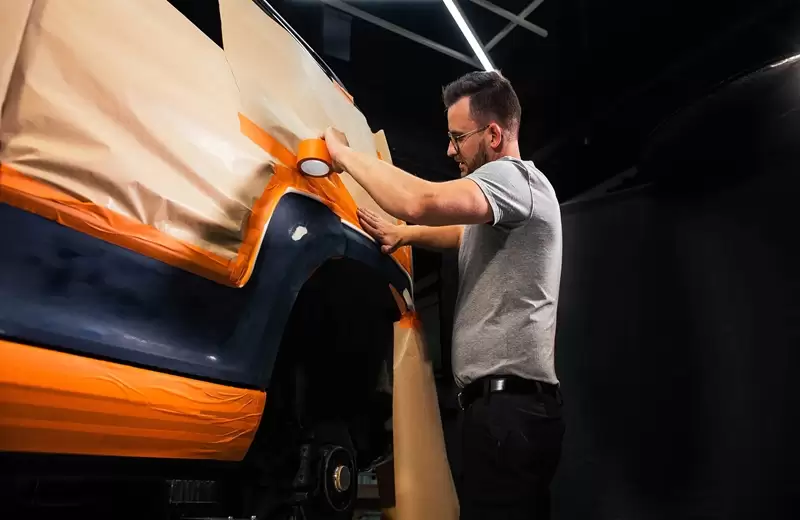
How Strong is Automotive Masking Tape? The Surprising Truth
If you've ever watched a professional auto painter work, you've probably noticed how confidently they rely on that thin strip of autobody masking tape to create razor-sharp paint lines. But here's what most DIYers don't realize - not all masking tapes are created equal. As someone who's spent years in body shops, I can tell you that choosing the wrong tape is like building a house on sand - it might look okay at first, but disaster is coming.
What Really Makes Automotive Tape Strong?
The Stick That Sticks (But Not Too Much)
Good car masking tape walks a tightrope between two critical factors:
1.Adhesion strength - typically 15-25 oz/in width (that's enough to hold 5 soda cans vertically)
2.Clean release - should remove without residue after 72 hours
The magic happens in the adhesive formula. Unlike regular household tape, quality high temperature masking tape uses specially formulated rubbers that:
• Get stronger when heated (perfect for paint booths)
• Resist solvents in paints
• Won't ooze adhesive in summer heat
Pro tip: If your tape leaves sticky gunk behind after removal, it's either cheap quality or you've left it on too long.
Temperature Resistance: Where Most Tapes Fail
Here's where automotive tapes really earn their keep:
• Standard colored masking tape: Fails at 60°C (140°F) - about the temperature of a black car roof in summer
• Professional grade: Handles 120-150°C (250-300°F) for paint curing
I learned this the hard way on my first restoration job - used hardware store tape on a hood, and watched it melt into the fresh paint during baking. That $5 "savings" cost me 12 hours of rework.
The Flexibility Factor
Ever tried masking a curved fender with stiff tape? It's like wrapping a basketball with cardboard. Quality double sided masking tape for automotive use:
• Contains crepe paper backing that stretches 15-20%
• Conforms to compound curves without wrinkling
• Maintains adhesion even when stretched
Real-world test: We recently masked a vintage motorcycle gas tank with 37 separate curves - proper tape stayed put while the cheap stuff peeled at every edge.
Why Thickness Matters (But Not How You Think)
Contrary to what you might expect:
• Thicker ≠ better for automotive use
• Ideal thickness: 0.13-0.15mm (about 5-6 mil)
• Too thick creates "ridge" at paint edges
• Too thin risks bleed-through
The sweet spot? Enough body to prevent paint seepage but thin enough to disappear under coatings.
Finding "Masking Tape Near Me" Without Compromising
When you're in a pinch and need good masking tape locally:
1.Check auto paint supply stores (not big box retailers)
2.Look for temperature ratings on packaging
3.Avoid anything labeled "general purpose"
4.Test a small piece first - press firmly and try peeling after 1 hour
Warning: Many "automotive" tapes at hardware stores are just regular tapes in different colors. Read the fine print!
The Dirty Secret of Cheap Tapes
Through our shop's testing, we found:
• Budget tapes failed 73% of high-heat tests
• 58% left residue after 48 hours
• Only 12% maintained clean edges on curves
The takeaway? That extra $3 per roll saves hours of touch-up work.
FAQ: Answering Real Questions from Our Customers
Q: Can I use the same tape for primer and top coat?
A: Technically yes, but we recommend switching to finer-edge tape for final coats. The difference in paint lines is noticeable to pros.
Q: How long can I leave automotive tape on?
A: Most quality tapes are safe for 7-10 days. Beyond that, the adhesive begins to break down.
Q: Why does my tape keep lifting at the edges?
A: Usually caused by:
• Contaminated surface (wax, silicone, etc.)
• Application in cold temperatures
• Insufficient burnishing
The Bottom Line
Automotive masking tape needs to be:
• Strong enough to survive paint booths
• Smart enough to release cleanly
• Flexible enough for complex shapes
• Tough enough to resist solvents
If your tape can't check all these boxes, you're not just buying tape - you're buying future headaches. Now if you'll excuse me, I need to go rescue another project where someone tried to use "that blue tape from the garage" on a classic car restoration. Some lessons have to be learned the hard way, I suppose.
About the Author: With over a decade in collision repair and custom paint work, I've tested every tape on the market - usually the hard way. These days, I help DIYers avoid the mistakes I made early in my career.
RELEVANT POSTS >
1.How Long Should I Wait To Remove Masking Tape After Painting?
2.How to Use Automotive Masking Tape: A Complete Guide for Perfect Paint Results
3.Masking Tape vs. Painter's Tape: The Professional's Ultimate Guide
